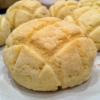
Nostalgia

Grew up eating this stuff. Custard buns. My cousin who now lives in Hong Kong sent me a recipe and I was able to make some... tears.


Grew up eating this stuff. Custard buns. My cousin who now lives in Hong Kong sent me a recipe and I was able to make some... tears.
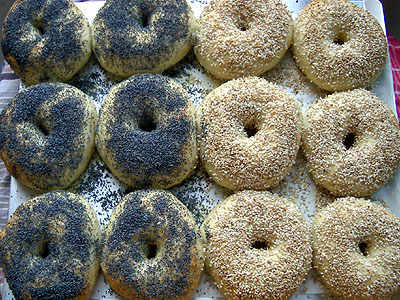
I don't know why, but I thought making bagels was considerably more complicated than making a loaf of bread. Well, it's not: it is easy.
A recipe and a description of how easy it was to make these below.
I knew making bagels involved boiling them. Somehow this left me with the impression that it would be as complicated as deep frying is, where you have to get the oil just the right temperature or else you end up either setting your kitchen on fire or eating little wet balls of grease. Plus there is the whole pot of grease clean up factor. Yuck. Not something I've wanted to deal with.
So when I read a couple of bagel recipes and all they said was "bring a pot of water to a boil. Drop bagels in and boil for a minute or two on each side" I... well, I felt like a dolt. Why didn't I try making these sooner?
About Bagels
There are a ton of bagel recipes out there. A large percentage of them include eggs and butter. Most suggest using high protein bread flour. Some include sugar, some include honey, and others include malt syrup or powder.
For my first time baking bagels, I decided to use the recipe from the The Bread Baker's Apprentice. It appealed to me because it had an extremely simple ingredient list (only one ingredient that don't routinely keep around the house, and it was simple to find and inexpensive) and included an overnight retardation of the dough that made it perfect for baking in the morning. As regular readers will recall, preparing bread in the evening for baking first thing in the morning is an ongoing desire of mine. This recipe fit that model perfectly.
Recipe
Makes 1 dozen bagels
Sponge:
1 teaspoon instant yeast
4 cups bread flour
2 1/2 cups waterDough:
1/2 teaspoon instant yeast
3 3/4 cups bread flour
2 3/4 teaspoons salt
2 teaspoons malt powder
OR
1 tablespoon malt syrup, honey, or brown sugarFinishing touches:
1 tablespoon baking soda for the water
Cornmeal for dusting the pan
Toppings for the bagels such as seeds, salt, onion, or garlic
The Night Before
Stir the yeast into the flour in a large mixing bowl. Add the water and stir until all ingredients are blended. Cover with plastic wrap and allow to rise for two hours.
Remove the plastic wrap and stir the additional yeast into the sponge. Add 3 cups of the flour, the malt powder (the one unusual ingredient, which I was able to find at the local health food store), and the salt into the bowl and mix until all of the ingredients form a ball. You need to work in the additional 3/4 cups of flour to stiffen the dough, either while still mixing in the bowl or while kneading. The dough should be stiffer and drier than normal bread dough, but moist enough that all of the ingredients are well blended.
Pour the dough out of the bowl onto a clean surface and knead for 10 minutes.
Immediately after kneading, split the dough into a dozen small pieces around 4 1/2 ounces each. Roll each piece into a ball and set it aside. When you have all 12 pieces made, cover them with a damp towel and let them rest for 20 minutes.
Shaping the bagel is a snap: punch your thumb through the center of each roll and then rotate the dough, working it so that the bagel is as even in width as possible.
Place the shaped bagels on an oiled sheet pan, with an inch or so of space between one another (use two pans, if you need to). If you have parchment paper, line the sheet pan with parchment and spray it lightly with oil before placing the bagels on the pan. Cover the pan with plastic (I put mine into a small plastic garbage bag) and allow the dough to rise for about 20 minutes.
The suggested method of testing whether the bagels are ready to retard is by dropping one of them into a bowl of cool water: if the bagel floats back up to the surface in under ten seconds it is ready to retard. If not, it needs to rise more. I didn't bother doing this, instead counting on it taking about 20 minutes to get my son's teeth brushed and get him to take a bath. In the quick interval between bath time and story time, I placed the pan into the refrigerator for the night.
Baking Day
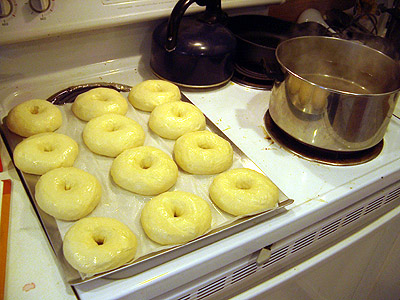
Preheat the oven to 500. Bring a large pot of water to a boil. Adding one tablespoon of baking soda to the pot to alkalize the water is suggested to replicate traditional bagel shop flavor. I went ahead and did this, though I have no idea if it made any difference.
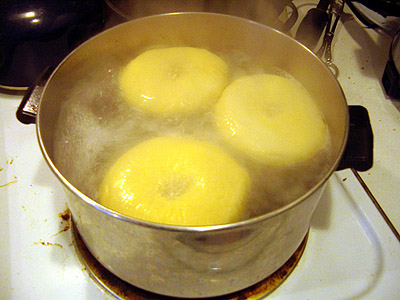
When the pot is boiling, drop a few of the bagels into the pot one at a time and let them boil for a minute. Use a large, slotted spoon or spatula to gently flip them over and boil them on the other side.
Before removing them from the pot, sprinkle corn meal onto the sheet pan. Remove them one at a time, set them back onto the sheet pan, and top them right away, while they are still slightly moist. Repeat this process until all of the bagels have been boiled and topped.
Once they have, place the sheet pan into the preheated oven and bake for 5 minutes. Reduce the heat to 450 degrees, rotate the pan, and bake for another 5 minutes until the bagels begin to brown. Remove the pan from the oven and let cool for as long as you can without succumbing to temptation.

Wrap Up
These bagels were awesome. I may try a different recipe next time, like an egg bagel recipe, but I have no complaints about this one.
I did learn that you can put too many seeds on top of a bagel. I went particularly overboard with the poppy seeds. Next time I'll use a few less, but the bagels were still a hit with everyone.

Related Recipes:Challah Bread, English Muffins, Struan Bread.

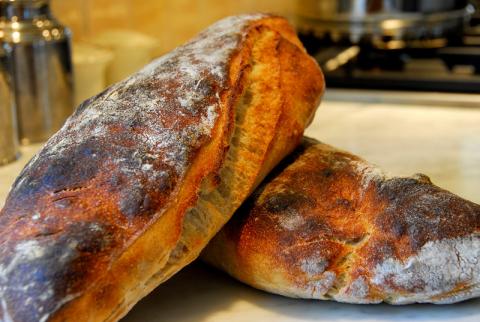
This is a new recipe I made from Daniel Leader’s book, Local Breads, for a Parisian loaf of Pierre Nury’s who is a recipient of the prestigious Meilleur Ouvrier de France award, as noted in the book.This is a very rustic light rye considered to be his signature loaf and is compared to Italian ciabatta.

It was very interesting to make and loads of fun although my timeline didn’t quite match Leader’s description of what would take place in the amount of time noted.I have made notes below in the recipe for how this worked for me.
This is delicious bread!I will definitely bake this loaf again.The recipe is so simple I see it as almost a no fail bread.The flavor is very good and I would describe it so far as the most tangy bread I’ve made to date keeping in mind my sourdoughs are very mild.I think it is really an outstanding flavor and toasted it is wonderful with a real depth of flavor.
The crumb is beautiful and very moist and almost spongy.It is very open like a ciabatta which just seemed so odd to me after such a long, overnight rise.

Here is the recipe for those of you who might like to give it a try.
Pierre Nury’s Rustic Light Rye – © Daniel Leader, Local Breads
Makes 2 long free-form loaves (18 ounces/518 grams each)Time:
8 – 12 hours to prepare the levain
20 minutes to mix and rest the dough
10 to 12 minutes to knead
3 to 4 hours to ferment
12 to 24 hours to retard
20 to 30 minutes to bake
Levain:
45 grams - stiff dough levain(45%)
50 grams – water (50%)
95 grams – bread flour, preferably high-gluten (I used KA Sir Lancelot) (95%)
5 grams – stone-ground whole wheat flour (5%)
Prepare levain by kneading and place into a covered container.Let stand at room temperature (70 to 75 degrees F) for 8 to 12 hours until it has risen into a dome and has doubled in volume.*
Bread dough:
400 grams – water (80%)
450 grams – bread flour, preferably high-gluten (I used Sir Lancelot) (90%)
50 grams – fine or medium rye flour (I used KA medium) (10%)
125 grams - levain starter**
10 grams – sea salt (I used kosher)
Mix:
Pour water into bowl of a stand mixer.Add the bread flour and rye flour and stir until it absorbs all of the water and a dough forms.Cover and autolyse for 20 minutes.
Knead:
Add the levain and salt.By machine, mix on medium speed (4 on a Kitchenaid mixer) until it is glossy, smooth and very stretchy for 12 to 14 minutes.***This dough is very sticky and will not clear the sides of the bowl.Give the dough a windowpane test to judge its readiness by gently stretching a golf-ball sized piece until it is thin enough to see through and not tear.If it tears mix for another 1 to 2 minutes and test again.To get maximum volume in the baked loaf, make sure not to under-knead.
Ferment:
Transfer dough to a lightly oiled container and cover.Leave to rise at room temperature (70 to 75 degrees) for 1 hour.It will inflate only slightly.
Turn: (stretch and fold):
Turn the dough twice at 1-hour intervals.After second turn, cover dough and leave to rise until it expands into a dome twice its original size, 1 to 2 hours more.****It will feel supple, airy, and less sticky.
Retard:
Place the container in the refrigerator and allow the dough to ferment slowly for 12 to 24 hours.It will develop flavor but not rise significantly.Two to 3 hours before you want to bake, remove from refrigerator and let stand on the counter, covered.It will not rise and will feel cool.
Preheat oven:About 1 hour before baking heat oven (with baking stone) to 450°F.
Shape loaves:
Scrape dough onto floured counter and coat the top of the dough with flour.Press the mound of dough into a rough 10-inch square. Cut dough into 2 equal pieces (18 ounces/518 grams each).With floured hands, lift up one piece from the ends and in one smooth motion, gently stretch it to about 12 inches long and let it fall in whatever shape it may onto parchment paper.Repeat with the remaining piece of dough, spacing the two pieces at least 2 inches apart.(No need to score.)
Bake:
Steam oven as usual.Immediately after shaping, slide loaves, on the parchment, onto the baking stone.Bake until crust underneath the swirls of flour is walnut-colored, 20 to 30 minutes.
Cool:
Cool on wire rack for about 1 hour before slicing.Don’t be surprised by the long troughs running through the crumb.This is part of the bread’s character.
Store:
Store loaves with cut side covered in plastic at room temp for 3 to 4 days.For longer storage, freeze in resealable plastic bags for up to 1 month.
http://zolablue.smugmug.com/gallery/4189134#244767439
NOTES:
*Leader says to allow the levain only to double in the amount of time noted.My starter more than tripled in less than 6 hours so at that time I mixed the dough.I think this may have slowed my fermentation way down since my starter had not fully risen and collapsed but I find I am always at odds with Leader’s instructions on firm starters.
**The levain recipe calls for ingredients which make up more than is needed for the dough recipe which I find problematic only because it bugs me.I want instructions for making the amount I need for a recipe and not to have any levain as leftover.He does this in some recipes and not in others so to me that is another flaw in their editing.Just make sure you weigh the proper amount for the dough recipe.
***I used a DLX mixer at about medium speed for roughly 10 to 12 minutes.
****My dough did not rise more than about 25% (if that) in the container in more than three hours after fermentation started.Again, I think that was due to using my levain too soon.I chose to place the dough in my pantry overnight to rise instead of the refrigerator since it had not doubled as it was supposed to by that time.My pantry is very cold at 62°F now as it is on an outside wall and this allowed a good spot for the dough to ferment overnight instead. It rose to just over double by the time I was ready to bake it.That fermentation took about 17 hours total.


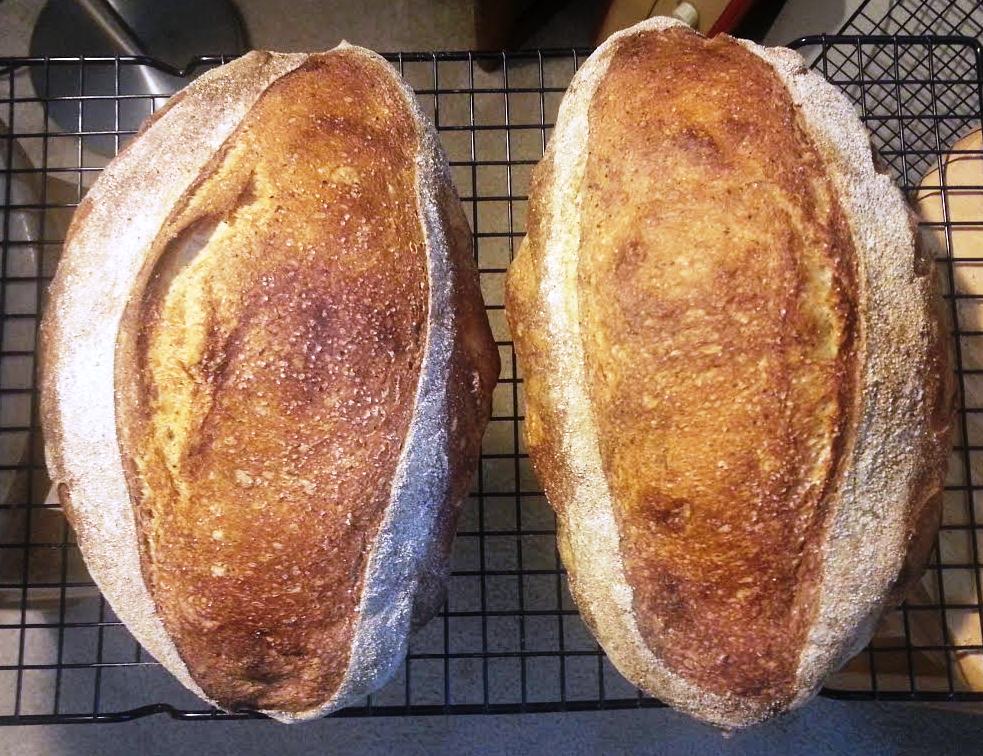

Hello, Fresh Loafers! I haven't posted a formula in awhile, and I think that this one for 76% hydration batards with rosemary and cream cheese is nice and reliable.
Ingredients:
550 g all-purpose or bread flour (substitute in 70 g whole wheat if you're going for country-style)
410 g cool water
100 g 100% hydration active white starter
12 g salt
6 g non-diastatic malt powder (sub brown sugar or honey if necessary)
1/4 tsp black pepper
1-2 tablespoons of fresh, very finely chopped rosemary (I used 1.5)
40 g cream cheese
40 g pate fermentee (optional)
Method:
1) Feed your starter/mix your levain such that you have 100 g of active starter by the time you want to mix your final dough.
2) Mix flour and water in a food safe container with a lid, and autolyse for 1-10 hours (I like a very long autolyse when I'm able to plan for it; it often works out that I allow my starter to ferment while autolysis is happening!)
3) Add starter, rosemary, cream cheese, pepper, salt, malt, and pate fermentee to the flour + water mixture. Pinch and squeeze until combined, and then stretch or slap-and-fold for 3-4 minutes.
4) Stretch-and-fold every 30 minutes for 2 hours.
5) Allow the dough to rest at room temperature until increased about 20% in size, between 30 minutes and 2 hours, then transfer the container to the refrigerator.
6) Retard in a refrigerator no warmer than 45 degrees F for 8-24 hours (the longer you retard, the more open your crumb will ultimately be, and the tangier the loaf; I was only able to retard for 8 for the batards below).
7) Remove the container from the refrigerator. Sprinkle flour over the top of the dough and spread over the top, then gently loosen the dough from the sides of the container, allowing flour to fall around the dough. Flip it onto a work surface so that the floured side forms the bottom of the loaves.
8) Carefully cut into two equal pieces. Gently pull each piece into a long oval.
9) Allow to rest for 5-10 minutes. (I am not big on pre-shaping, so these ovals are quite loosely formed.)
10) Shape into batards using whatever method you are most comfortable with. One day soon, I will share pictures of my method of batard shaping -- it's the one I'm most consistently successful with as a novice home baker!
11) Allow the loaves to proof in a couche seam-side up for 45 minutes to 1 hour, or until increased roughly 40-50% in size. Watch carefully at this stage!
12) Optional: Transfer the couche to the freezer for 10 minutes. This step is not absolutely necessary, but I find that the "freezer trick" helps with both oven-spring and ease of scoring.
13) Score and bake the loaves at 475 degrees F for 15 minutes with steam, then 20-25 minutes without steam. For small batards such as these, I love to bake on the stone, with a turkey roaster lid creating the steam. For some reason, the crust I achieve this way is thinner and crispier than the crust I achieve using a dutch oven.
Rosemary is a slightly divisive herb, but I find that those who like it really, really like it. This bread is great as a side for a hearty meal, eaten straight with olive oil, or, my personal favorite: A smear of apricot jam.
Enjoy!
And some bonus photos of loaves created since the last time I posted:


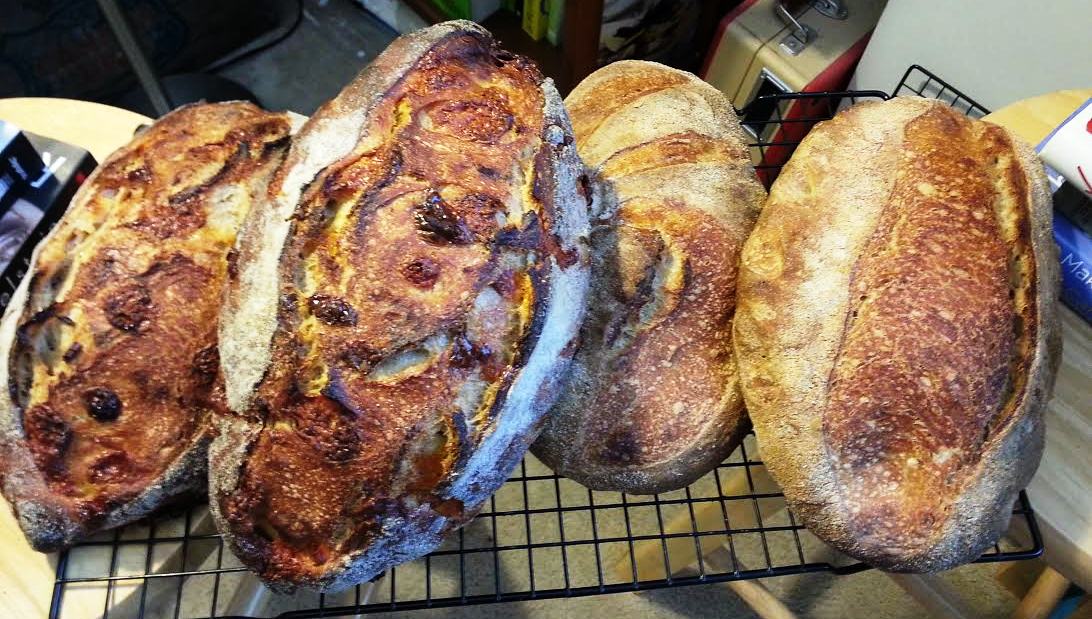

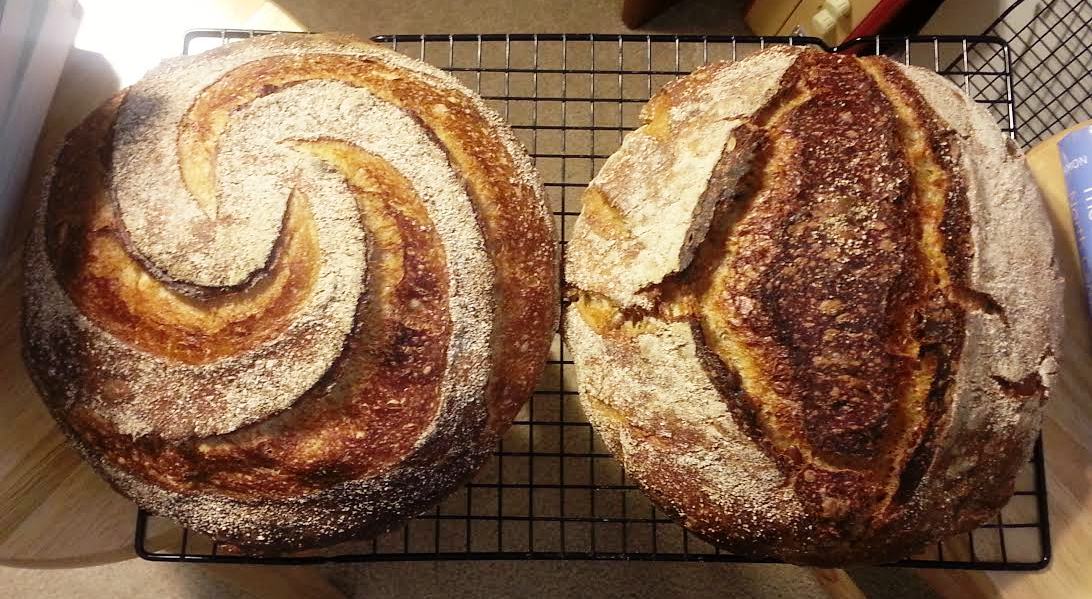

In the 15 years since I first tried Brother Juniper's Struan Bread, I've tasted a lot of great bread, but I still don't think I've tried anything that makes as great toast as Struan Bread does. Nor have I tried any bread is so universally enjoyed: everyone who tries it agrees that this bread makes killer toast.
It isn't bad for sandwiches either.
I have to admit though that this bread occasionally gives me nightmares. Click "Read More" to learn why.
The Nightmares
When I was in high school I worked in the Brother Juniper's bakery and cafe. For the most part I worked on the slicing machine, but I also helped scale and shape the loaves. Oh yes, and top the loaves with poppy seeds.
The poppy seeds. The poppy seeds are what give me nightmares.
I have no idea how many pounds of poppy seeds we went through a day, but I know we made as many as 500 loaves of Struan Bread, each one covered with hundreds of poppy seeds. Those seeds would get everywhere: in your hair, under your fingernails, in your clothes, everywhere you can imagine. Even a few places you can't imagine: I recall a number of times pulling poppy seeds out of strange places (like my book bag for school or a clean pair of pants) and wondering "How in the world did poppy seeds get in there?!?
I still avoid poppy seeds most of the time, though I'll admit they are wonderful on top of this loaf.
About Struan Bread
Struan Bread (properly pronounced "STRU-en bread", but most people I know call it "STRON bread") is a harvest bread. I believe the story is that Peter Reinhart read something about a traditional bread that Irish villagers baked into which they threw a little bit of everything they were harvesting. Struan Bread as we know it is an attempt to capture the spirit of that loaf.
Regardless of the origin, this bread is wonderful. One is certainly free to experiment with including different or additional grains. I've done so a bit and the bread has turned out quite good, though I don't think any of them have be as excellent as the combination found in the original recipe (reproduced below).
Oh yeah, I need to add that this recipe is roughly the recipe found in Peter Reinhart's Bread Baker's Apprentice. I believe he includes versions of it in most of his other baking books (Crust & Crumb and Brother Juniper's Bread Book come to mind). If you don't already have one of his bread books on your shelf you owe it to yourself to pick one up.
Struan Bread
Makes 1 large loaf or 2 small loaves
Soaker
3 tablespoons polenta
3 tablespoons rolled oats
2 tablespoons wheat bran
1/4 cup waterDough
3 cups unbleached bread flour
3 tablespoons brown sugar
1 1/2 teaspoons salt
1 tablespoon instant yeast
3 tablespoons cooked brown rice
1 1/2 tablespoons honey
1/2 cup buttermilk
3/4 cup watertopping
1 tablespoon poppy seeds
Mix together the ingredients for the soaker. Cover and allow to soak for at least half an hour or as long as overnight.
In a larger bowl, combine the dry ingredients, then stir in wet ingredients and soaker. Add more flour or water until the dough can be formed into a ball that is tacky but not sticky. Place the ball of dough on a clean work surface and knead it for 10 to 12 minutes, then return it to the bowl. Cover the bowl with plastic wrap and allow the dough to ferment until doubled in size, approximately 90 minutes.
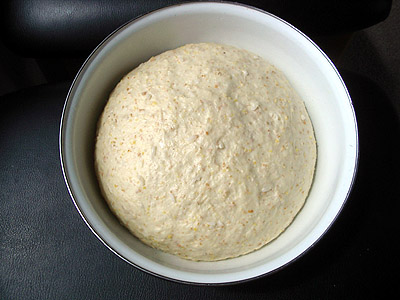
Remove the dough from the bowl, degas it gently, and split it for two loaves or shape it as is for one. Place the loaves in greased bread pans, spritz or sprinkle water on top, and sprinkle a handful of poppy seeds on top.
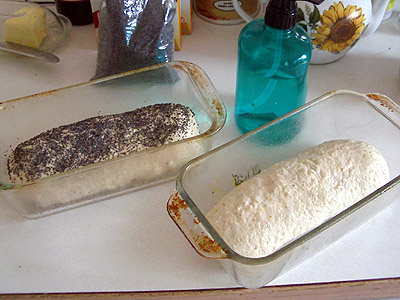
Cover the pans loosely with plastic and allow the loaves to rise until doubled in size again, approximately 90 minutes.
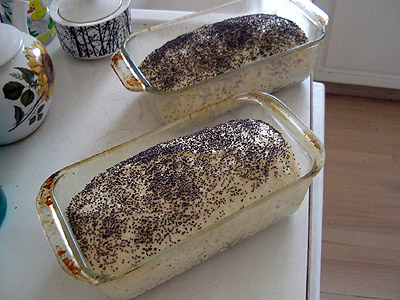
Bake these loaves at 350 for 40 to 60 minutes, until the internal temperature is around 190 degrees. When ready the loaves will be quite brown on top and will make a hollow thud when tapped on the bottom.
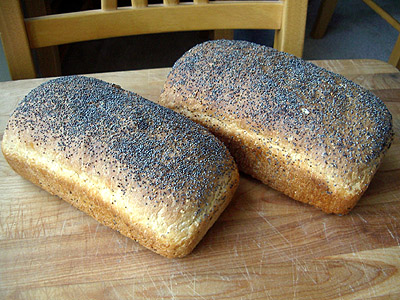
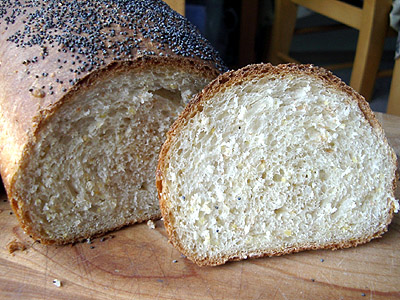
Doesn't that look good? Trust me, it is WONDERFUL! Try it, it is worth the work!
Related Recipes: Maple Oatmeal Bread


I used some of my starter that would have been discarded last night during refreshment to make some english muffins. I found this recipe about 3 years ago on the KAF Baking Circle. It was submitted by a user going by the name chard. It makes great english muffins!

The texture is similar to Wolfermans, not big "nooks and crannies", but a little meatier. I know a wetter dough would create larger holes, but I like them this way. I used semolina on the parchment while they rested, and the flavor it gives to the bottom of the muffin is fantastic. Other than only using 2 cups of flour for the whole recipe, I followed the amounts and ingredients exactly.
Sourdough English Muffins
Makes about 12
1/2 C starter (mine is a 100% hydration white starter)
1 C milk
2-3/4 C AP flour
1 TBSP sugar
3/4 tsp salt
1 tsp baking soda
Semolina or cornmeal, for dusting
Combine starter, 2 C of flour and milk in a large bowl. Stir to combine, cover with plastic wrap, and leave out for 8 hours or overnight.
After the overnight rest, add remaining flour (I didn't add any), sugar, salt and baking soda and mix well. Turn onto a lightly floured surface and knead for 4-5 minutes. Roll out to 3/4" and cut with a biscuit cutter into rounds. You can reroll the scraps, but you may need to let the dough rest before cutting more muffins from them. Place muffins on a piece of parchment dusted with semolina and let rest for 45 minutes.
Spray griddle or skillet lightly with spray oil. Heat to medium and cook muffins for about 6-8 minutes on each side, or until browned on the top and bottom and cooked through. These have great griddle spring and rise quite a bit during the "baking".
Split with a fork and enjoy with your favorite topping! I don't even toast them if I want to eat them right off the griddle--they don't have that raw taste that storebought english muffins have.
Enjoy!

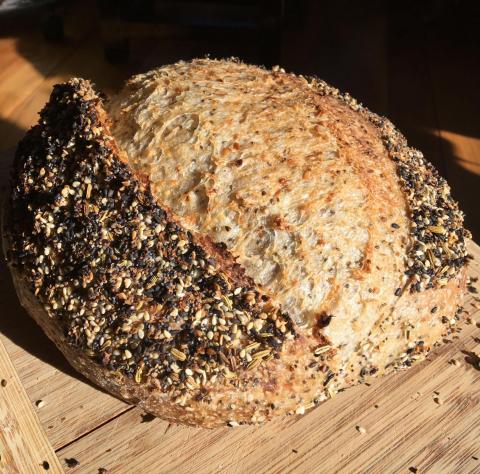
Naturally Leavened seeded sourdough with chia, golden flax, and hemp seeds. Crusted with everything topping. Nutritionally dense and packed with flavor.
Soaker
60g hemp seed
60g ground flax seed
60g chia seed
360g h20 @210F
Dough
580g bread flour (I used locally milled)
144g whole wheat (I milled my own hard red winter wheat)
22g wheat germ
557g H20 (77%)
17g salt (2.4%)
110g active sourdough starter (100% hydration)
Everything Topping
Combine the following-
Equal parts dried onion, dried garlic, poppy seeds, sesame seeds, fennel seeds
Salt to taste (A good amount of quality flake salt or coarse kosher salt)
Fresh ground black pepper to taste
Prepare the Soaker:
Mix the chia, hemp, and ground flax seeds together in a vessel large enough to hold them and the water. Heat the water to 210 F and pour over the seeds. Mix together and let stand 1 hr or overnight.
Prepare the dough:
Mix flours and germ to combine. Scale the water and pour 10-20 g of it over the scaled salt. Set salt/water aside. Add remaining water to flour and mix to create a shaggy dough. Autolyse 30 min to 1 hr.
Add starter to dough and mix to combine. Once the starter is incorporated, add the reserved salt/water mixture. Mix to combine.
Mix the dough to develop gluten. I use my kitchen aid stand mixer with the hook on medium speed, takes 6-7 minutes to reach full development.
Bulk ferment for 3-6 hours depending on your temps. Stretch & fold dough every thirty minutes for first 1 1/2 hours. Add seed soaker during second set of folds. Fold once every hour or so until dough has risen 30-50%
Scale dough, pre-shape and shape as desired, I do two 950g loaves because that's what fits into my combo-cooker dutch ovens. Pre-shape should sit at least 20 minutes before shaping. You can either evenly sprinkle your tea-towel lined banneton with the everything topping or if you make enough roll the whole loaves in the topping before you place into the banneton. Cold proof loaves overnight in the fridge.
Next day preheat oven with combo cooker lids (larger part) inside as hot as your oven will go. My goes 550F. Preheat at least 1 hour. When oven is ready take the dough from the fridge, turn it out into the combo cooker base which is lined with parchment or sprinkled with semolina. Slash loaf as desired. Bake covered at 550F for ten minutes. Lower oven temp to 450F and bake additional 15 minutes. Remove lid and bake until desired color is reached and internal temp of loaf is at least 205F. Takes about 5 minutes in my oven. Cool at least 2 hrs before slicing.
Enjoy!


Our family traveled to Spain this past Spring, and Sevilla was our favorite city on the trip, we were there during Semana Santa. We particularly enjoyed the Tortas de Aceite- yeast-leavened olive oil wafters laced with sesame and anise. This version is a little different than the standard torta in that it is leavened with sourdough and uses star anise instead of anise seed.
A view of the courtyard in Sevilla's Alcazar, the Royal Palace.

Tortas de Aceite Recipe
| Levain | Baker's % | ||||||
| Sourdough starter, 60% hyd. | 6g | Total flour | 200g | ||||
| KAF AP | 30g | White flour | 100% | ||||
| Water, room temp | 18g | Hydration | 60% | ||||
| Salt | 0.7% | ||||||
| Main Dough | Levain flour | 10% | |||||
| Unbleached AP, 10% protein | 180g | Sugar | 6% | ||||
| Sesame seeds, toasted | 1Tb + 3/4 tsp | Olive oil | 27% | ||||
| Sugar | 1 Tb | ||||||
| Salt | 1/4 tsp | ||||||
| Water, room temp | 108g | ||||||
| Levain | 32g | ||||||
| Olive oil | 54g | ||||||
| Topping | |||||||
| Star anise | 1 piece | ||||||
| Granulated sugar | 2 tsp + 2 Tbs | ||||||
Night Before:
Mix levain, allow to ferment ovenight at 68-70F. It should rise but not yet be fully mature.
Next Morning:
Weigh flour into mixing bowl and coat a 3-4 cup bulk ferment container with olive oil.
Use spice grinder to grind toasted sesame seeds, salt and main dough sugar until fine. Stir into flour.
Add 32g levain (the rest is for perpetuating the culture), water and oil to the flour mixture and mix until combined, then knead by hand about 10 minutes.
Transfer to oiled container and cover.
Ferment until dough has doubled, about 5 hours at 81F.
Using olive oil to grease work surfaces and dough, stretch and fold 3 times in first 3.5 hours, then allow to rise. Ready when rounded peak reaches a little past 2 2/3 cups.
Afternoon:
Divide and pre-shape into 12 rounds. Place on oiled sheet pan and rest one hour, covered.
In spice grinder, grind star anise with 2 tsp sugar until fine, then scrape into bowl.
Preheat oven to 450F, placing rack in middle of oven. Prep a half sheet pan with silpat or parchment.
Spread 2 Tbs granulated sugar on a plate.
Flatten dough balls slightly, then sprinkle the top with 1/4 tsp of the anise-sugar mixture. Spread mixture over dough disc with fingertip.
Shape six discs into pizza-like tortas about 3 1/2 inches in diameter, then turn face down in sugar plate to coat with sugar.
Place six tortas on one half sheet pan and bake 8 minutes, then rotate and bake 3-5 more minutes, until nicely caramelized.
Repeat with remaining six tortas.
Editing to add notes:
Don't be tempted to add the anise into the main dough- it has potent anti-bacterial and anti-fungal qualities and will kill off every discernable trace of sourdough culture (did this with my first go at these).
These re-heat and re-crisp beautifully in the toaster.
Dough Rounds:
Flattened Discs with Anise-Sugar Mixture:

The Shaped Tortas:
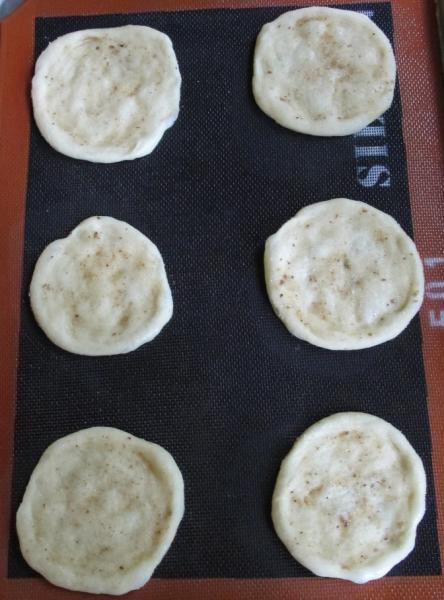
Plaza Nueva at Sunset:

Sevilla's Cathedral:

Torta Crumb:

More Tortas:

Looking for Tapas:


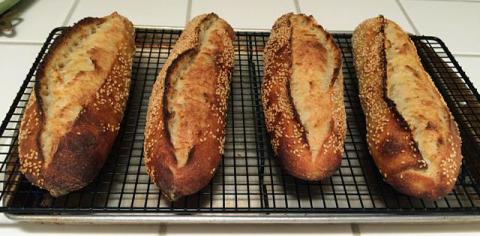
Sourdough Italian Demi-Baguettes: Variations on a Theme
David M. Snyder
May 3, 2015
Last month, I made some Sourdough Italian Rolls, using a formula I had developed and used previously to make bâtards. This week, I continued to play with this formula. I increased the proportion of durum flour in the dough, doubling the amount in the final dough, and I shaped the dough as demi-baguettes. (I wanted to make bâtards. My wife wanted more rolls to use for sandwiches. Demi-Baguettes was the compromise. We use that shape for sandwiches frequently.)
Total Dough |
|
|
Ingredient | Amount (gms) | Bakers' % |
AP flour | 334 | 60.7 |
Fine Durum flour | 200 | 36.4 |
WW flour | 11 | 2 |
Whole Rye flour | 5 | 1 |
Water | 400 | 72.7 |
Salt | 10 | 1.8 |
Sugar | 14 | 2.5 |
EVOO | 14 | 2.5 |
Total | 988 | 179.6 |
Liquid Levain |
|
|
Ingredient | Amount (gms) | Bakers' % |
Liquid starter | 40 | 40 |
Water | 100 | 100 |
AP flour | 70 | 70 |
WW flour | 20 | 20 |
Whole Rye flour | 10 | 10 |
Total | 240 | 240 |
Disperse the liquid starter in the water.
Add the flours and mix thoroughly.
Ferment at room temperature until expanded and bubbly (8-12 hours). If necessary, refrigerate overnight and let warm up for an hour before using.
Final Dough |
|
Ingredient | Amount (gms) |
AP flour | 300 |
Fine Durum flour | 200 |
Water | 350 |
Salt | 10 |
Sugar | 14 |
Active liquid levain | 100 |
EVOO | 14 |
Total | 988 |
Procedures
In a large bowl, disperse the levain in the water.
Add the flours and sugar to the liquid and mix to a shaggy mass.
Cover the bowl and let it rest for 20-60 minutes.
Add the salt and olive oil and mix thoroughly. (Note: I squish the dough with my hands until it comes back together, then do stretch and folds in the bowl until it forms a smooth ball and the oil appears completely incorporated.)
Transfer the dough to a 2 quart lightly oiled bowl, and cover the bowl tightly.
After 30 minutes, do stretch and folds in the bowl. Repeat 3 more times at 30 minute intervals.
Continue bulk fermentation for another 30-90 minutes, until the dough is puffy. If fermented in a glass bowl, you should see lots of little bubbles throughout the dough. Volume of the dough may have increased by 50% or so.
Refrigerate for 12-36 hours.
Divide the dough into 4 equal pieces and pre-shape as rounds or logs. Cover with a clean towel, baker's linen or plasti-crap and let rest for one hour.
Shape as Demi-Baguettes or Ficelles.
Roll the loaves on damp paper towels, then in a tray of sesame seeds. Alternatively, you can brush the loaves with water and sprinkle with sesame seeds.
Proof for about 45 minutes, seam-side down, on parchment paper pleated to separate the loaves and supported at both long sides by rolled-up dish towels. Cover with a damp towel, baker's linen or plasti-crap.
One hour before baking, pre-heat the oven to 480ºF with a baking stone and steaming apparatus in place.
When ready to bake, uncover the loaves. Pull the parchment from both long sides to flatten out the pleats and separate the loaves.
Transfer the loaves, on the parchment, to a peel. Score them as baguettes. Transfer them to the baking stone.
Steam the oven, and turn the temperature down to 460ºF.
After 10-12 minutes, remove the steaming apparatus. (Note: If you have a convection oven, switch to convection bake and turn the oven down to 435ºF for the remainder of the bake.) Continue baking for another 6-8 minutes or until the loaves are nicely browned and the internal temperature is at least 205ºF.
Transfer the loaves to a cooling rack. Cool completely before eating.


After cooling, the Italian bread crust was soft. The crumb was nicely aerated, but not as open as expected for this level of hydration. I suspect this is because of the durum flour (higher protein but poorer quality gluten) and the extra handling installing the sesame seeds. The flavor is heavenly. This is a sweet white roll with the nuttiness of durum and sesame seeds, dipped in high quality EVOO. How could that not be delicious?
One of the baguettes was consumed for dinner.

Panino with roast chicken breast, caramelized onions with balsamic vinegar, sliced dried calmyrna figs, emmenthaler cheese and a light smear of Dijon mustard.
Such a sandwich can only be washed down with good Italian beer, of course.
I also baked a couple boules based on the "Overnight Country Blonde" from Ken Forkish's Flour Water Salt Yeast. Summer has arrived, and my kitchen is running 75 to 78 dF, so fermentation runs faster than the book specifies. The result is that bulk fermentation was complete in 5 hours. I refrigerated the dough overnight and divided and shaped the next morning. Even with the dough starting out cold, proofing was complete in about 2 hours.
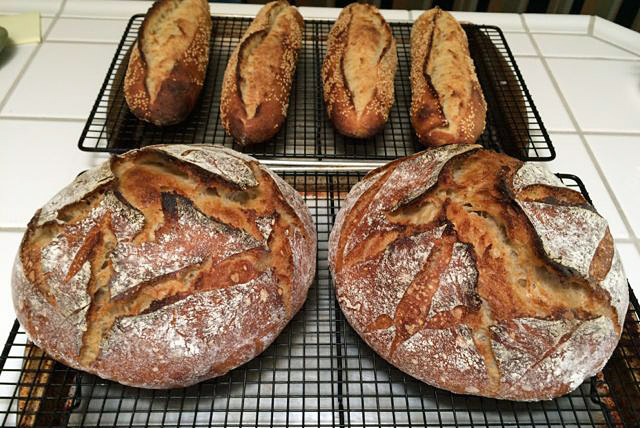

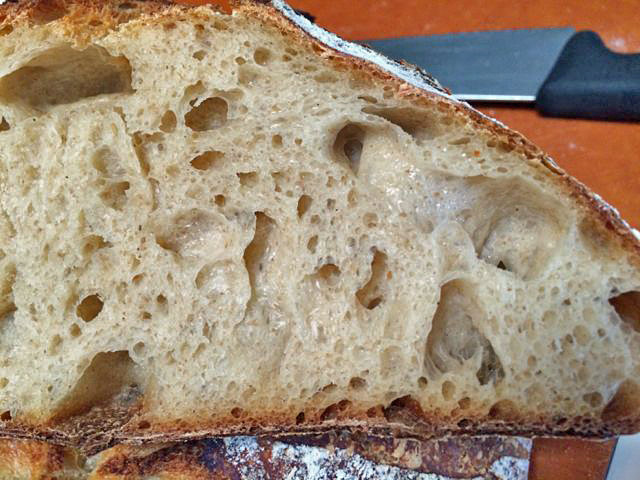
All of the sourdough breads I have made from FWSY have a strong family resemblance but more or less distinctive flavor profiles, depending on the flour mix used, the percentage pre-fermented flour and the fermentation routine. This bread had a crunchy crust and cool, chewy crumb. The flavor had that nice wheaty sweetness and a quite present but mild sourdough tang, with the creamy lactic acid tone dominating. Although this is a higher hydration dough, the flavor profile is very much like the Pain de Campagne from Hamelman's Bread. And that's not bad! Like my San Joaquin Sourdough, it contains mostly AP flour but with about 10% whole grain flours, divided between whole wheat and whole rye. The procedures I used for this bake, with the overnight retardation before dividing and shaping, gave such nice results, I am going to use it for a while and try increasing the whole grain flours, maybe adding some toasted wheat germ for its nutty flavor and who knows what else.
It has been a good bread baking day.
Happy baking!
David


Steel-cut Oat Bread
Makes two large loaves.
Steps1 evening before bake day
1. Refresh 100% starter to yield +200 grams for the next morning. Overnight room temps can be 60F. Use 50 gm whole wheat, 50 gm AP, 100 gm H2O and 30 gm natural leaven at 100% hydration.
Steps 2 - 12 , bake day AM. Work at 70F
2. Pour 600 gm boiling H2O over 300 gm steel cut oats in a pot or bowl with a lid or cover. Stir the oats once and cover. Let steep 45 minutes.
3. (45 minutes later) Pour the steel cut oats and associated water into a large sieve set over a bowl. Let drain about 30 minutes but capture and reserve the water. After 10 minutes use the accumulated water.
4. Into your bulk dough bowl, add the oat water and enough other water to yield 650 gm.
5. Add to the bulk dough water, 200 gm starter and whisk to incorporate.
6. In a small bowl add 50 gm of remaining oat drainage water (add more water if necessary) to 25 gm kosher salt. Set aside.
7. Add 1 kg AP flour to water and starter in bulk dough bowl. Mix by hand or on a work surface until all flour is moistened. Dough may be rather stiff.
8. Let dough autolyse for 30 minutes.
9. Add salt and associated water to dough by hand. When the salt-water is incorporated, do a set of stretch and folds. Return to bowl and let rest 30 minutes. Do another set of stretch and folds. Let rest 30 minutes.
10. Add the oats. Turn the dough out on to a wet work surface. Stretch the dough into a large rectangle. Incorporate the oats using letter folds. [Sprinkle 1/3 of the steel cut oats on to the middle 1/3 of the dough. Fold an end 1/3 of the dough over the oats. Sprinkle another 1/3 of the oats over the middle and fold the final 1/3 of the dough over the middle. turn the dough and sprinkle 1/2 of the remaining oats over the middle. Fold the end over the middle, sprinkle the remaining oats over the middle and fold again.] Give the dough a few kneads to ensure good distribution of the oats. Return the dough to the bowl. Cover and rest at 70F until doubled ( maybe 3-4 hrs.)
11. Turn the dough out on to a lightly floured surface. Divide in half. Form into balls and let rest 15 minutes. Shape into logs (for oval loaves) or rounds (for boules) depending on whether you are baking in round or oval dutch ovens (or oval Romertopfs , as I do). Roll smooth (non-seam) surface of shaped doughs into rolled oats to cover the surface and place seam side up into appropriately shaped forms. Let proof about 1hr 30 minutes at 70F.
12. At the 1 hr, 30 minute mark, place dutch ovens into oven and preheat to 500F for about 30 minutes. Remove dutch ovens, turn loaves out onto dusted work surface, score, place into dutch ovens, cover and place in the oven. Lower oven temp to 475F and bake 30 minutes. Remove dutch oven covers and bake for 25-30 minutes uncovered at 450F. Let cool completely. While they can be eaten as soon as completely cooled, the loaves will hold perfectly, uncut, 1-2 days as the moisture from the steel-cut oats permeates the crumb.